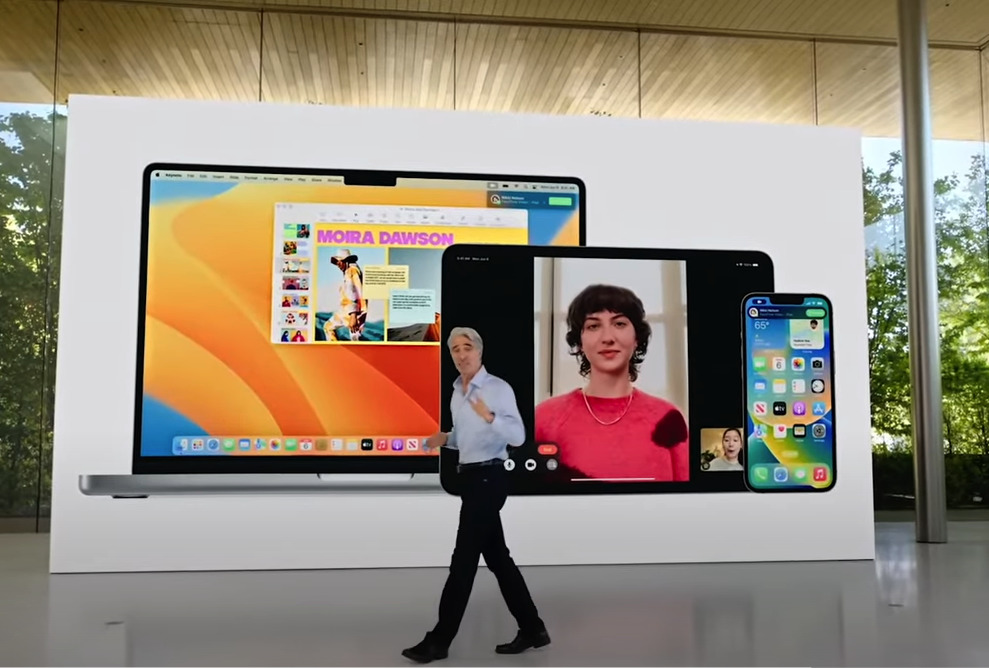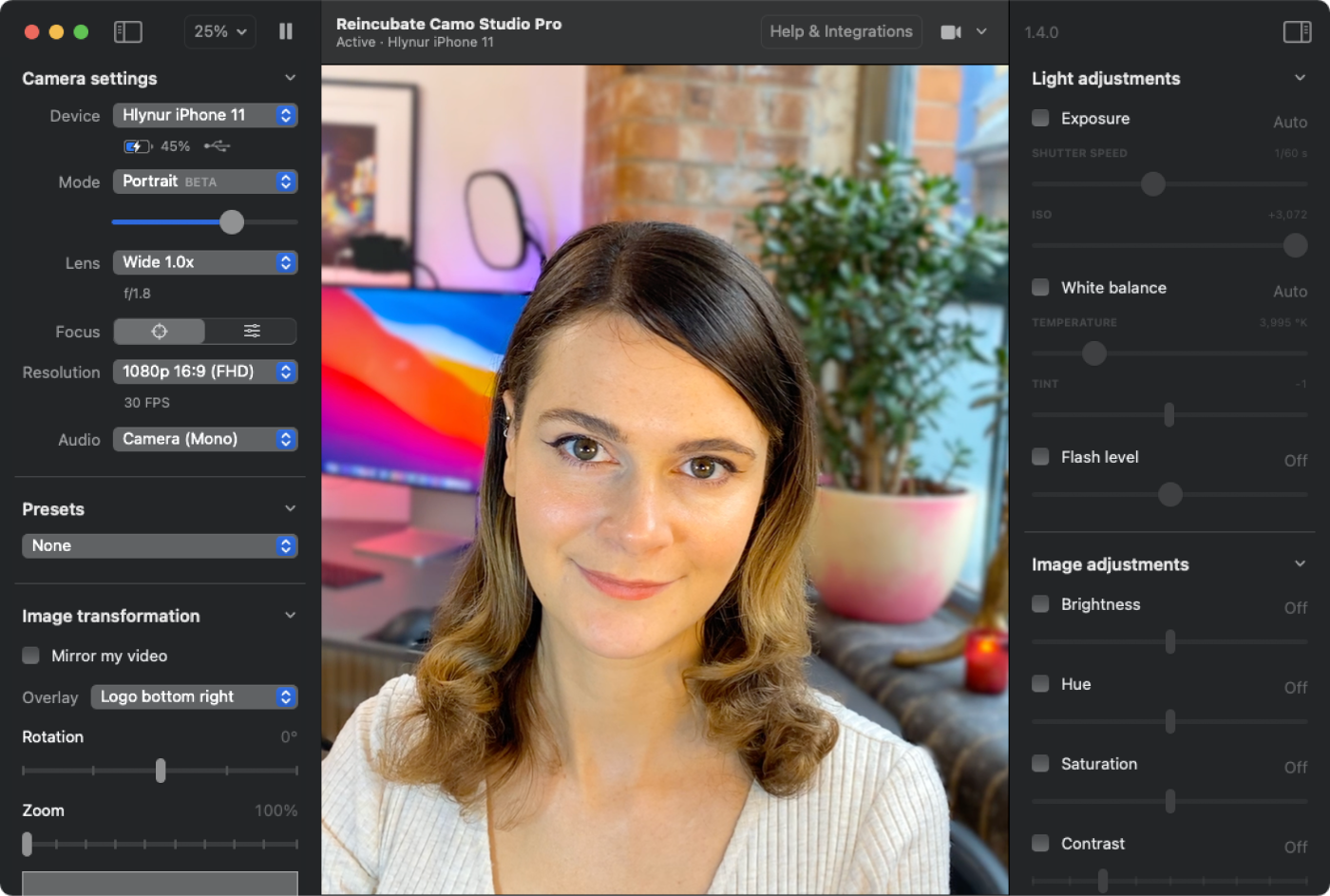In February 2022, I published my initial review of Camo Pro, which I called “the software CCU for your phone camera” which turns it into a webcam for your macOS or Windows computer. Last week at WWDC, Apple announced its new Continuity Cam as part of the upcoming macOS version, to be called Ventura. I see some overlap between the raw Continuity Cam and Camo Pro, but I also see many differences. At first, Continuity Cam might be seen as a competitor for Camo Pro (albeit with many pros and cons), but Continuity Cam could potentially add new capabilities to a future version of Camo Pro, after macOS Ventura is released. Ahead, I’ll compare the two as if they were competitors. I’ll applaud Apple for spelling Ventura properly (after misspelling both El Capitán and Monterrey). Then I’ll speculate how a potential future version of Camo Pro could combine the best of today’s Camo Pro with the special features added by Continuity Cam as a macOS Ventura service.

Link to my initial review of Camo Pro
Initial Review: Camo Pro, the software CCU for your phone camera
Fortunately, Apple spelled Ventura correctly
After misspelling two other macOS systems: Monterrey (which should have a double R) and El Capitán (which needs an accent mark), I am thrilled to see that Apple spelled Ventura correctly for the new operating system. Whether Apple chose the name for the Dominican merengue singer Johnny Ventura (born as Juan de Dios Ventura Soriano, 1940-2021, R.I.P), for the actor/ex-wrestler/ex Governor of Minnesota, Jesse Ventura (born as James George Janos) or more likely for Ventura County, California, I am so glad Apple got the spelling right this time.
Comparing today’s Camo Pro and Continuity Cam (as presented at WWDC 2022)
Both Camo Pro and Apple’s Continuity Cam recognize that most built-in and many standalone webcams are terrible compared with the much higher quality rear cameras in today’s smartphones. That’s where they agree. Then the differences appear, as you’ll see in this chart I created:
| Continuity Cam as presented by Apple at WWDC |
Camo Pro as of publication date |
|
| Smartphone compatibility | iPhone only (or possibly iPod Touch/iPad too) |
Android phones/tablets or |
| Computer host compatibility | macOS Ventura | macOS Catalina and beyond Windows 10 and beyond |
| Connection to host computer | Wireless: bluetooth and wifi |
Wired: USB<>Lightning(which I prefer—See the next section.) |
| Smartphone login to same Apple account as desktop | Required. The iPhone must be logged into the same Apple account and must have both bluetooth and wifi active. |
Not necessary at all. The smartphone may be associated with a different account and may be in Airplane Mode. |
| “Portrait” (reduced depth of field via software) | Yes (possibly camera dependent) |
Yes (camera dependent) |
| Studio Light feature: Automatically brightens face and darkens the background, simulating a ring light in software. | Yes | Not automatically. The same result may be possible via manual controls. |
| Desk View feature: Uses the ultrawide camera to show the desk in split screen mode, as if there were a second overhead camera (see video below). This all happens via computational image processing. | Yes | Not presently. |
| Deep manual control of smartphone’s camera,. | Not as shown by Apple at WWDC |
Yes, with the option of leaving autofocus and/or auto exposure if desired. |
The above video is courtesy of CNET and Apple’s WWDC.
How I visualize Camo Pro in the future, using Continuity Cam as a macOS Ventura service
I am only dreaming here. I would like the best functions already available from Camo Pro to gain the superpowers of the Desk View feature and perhaps the Studio LIght (both described and illustrated in the prior section).
Even though some people (who never tried it yet) may consider using the same smartphone as a webcam and as their personal telephone, after trying that, I decided to get a separate iPhone SE as a permanent webcam with Camo Pro. The main reason is because too often an unexpected phone call will dismantle the setup. I also prefer the smartphone to be wired to the host computer, both to have continuous power, better reliability of the setup and less radiation. I chose a refurbished iPhone SE because it has a very high quality rear camera (remotely controlled by Camo Pro) and the smallest footprint when mounted in front of a computer screen (not on top of it) with a transparent PlexiCam together with the optional Smartphone Holder.
Above image, courtesy of PlexiCam.
That way, better simulated eye contact can be achieved, as with a teleprompter. Even though the PlexiCam is fortunately transparent, the smartphone is not. That’s why I chose the smartphone with the smallest footprint, together with a high-quality rear camera controlled by Camo Pro. Per my research, that’s the iPhone SE.
I’ll be publishing a fuller review of Camo Pro (together with PlexiCam) as soon as Camo Pro adds the framerate option, which is scheduled to be added sometime during 2022. Be sure to be on one of my mailing lists shown below to be notified when I publish that or other articles and reviews.
(Re-)Subscribe for upcoming articles, reviews, radio shows, books and seminars/webinars
Stand by for upcoming articles, reviews, books and courses by subscribing to my bulletins.
In English:
- Email bulletins, bulletins.AllanTepper.com
- In Telegram, t.me/TecnoTurBulletins
- Twitter (bilingual), AllanLTepper
En castellano:
- Boletines por correo electrónico, boletines.AllanTepper.com
- En Telegram, t.me/boletinesdeAllan
- Twitter (bilingüe), AllanLTepper
Most of my current books are at books.AllanTepper.com, and also visit AllanTepper.com and radio.AllanTepper.com.
FTC disclosure
Some of the manufacturers listed above have contracted Tépper and/or TecnoTur LLC to carry out consulting and/or translations/localizations/transcreations. Many of the above manufacturers have sent review units to Allan Tépper so he can do his reviews. So far, none of the manufacturers listed above is/are sponsors of the TecnoTur, BeyondPodcasting, CapicúaFM or TuSaludSecreta programs, although they are welcome to do so, and some are, may be (or may have been) sponsors of ProVideo Coalition magazine. Some links to third parties listed in this article and/or on this web page may indirectly benefit TecnoTur LLC via affiliate programs. Allan Tépper’s opinions are his own. Allan Tépper is not liable for misuse or misunderstanding of information he shares.


